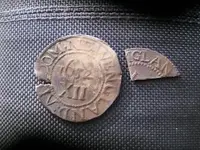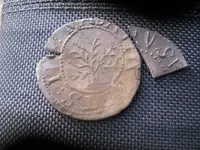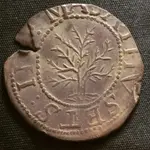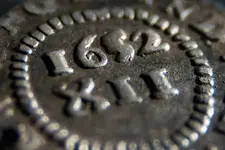I've always wondered how many Massachusetts Bay silvers were minted by Hull and Saunderson. Below is an excerpt from Studies on John Hull, the Mint and Economics of Massachusetts Coinage speaking to just coinage produced in 1679 based upon Hull's ledgers. Extrapolate this over the course of the mint's history, and it becomes clear that MANY tree coins should be ripe for discovery...
"Clearly, like all other mints, the Massachusetts Bay mint lost some silver as waste during the minting process. Realizing there had to have been some loss, and also realizing Hull produced more that 80d in coinage per troy ounce, it is clear the average coin weight was below 72 grains per shilling. As the mint committee allowed a wastage allowance of 1d per troy ounce, it seems Hull interpreted this regulation as giving him a remedy or tolerance of six grains of sterling per troy ounce. This was not a per coin toleration but a per ounce toleration, thus individual shillings may be above or below the 71.1 grains average but the sum total of the coinage per ounce was limited to a loss of six grains. Thus, I shall use six grains per ounce as the maximum wastage or loss in the caluculations below. However, it is quite possible Hull was actually able to control wastage so that the average waste per troy ounce was less than six grains. Therefore, I shall review the 1679 consignments for average coin weight estimating absolutely no wastage, then estimating the maximum six grains per ounce of wastage and finally estimating a median actual wastage of three grains per troy ounce.
For simplicity, I have assumed all of coins produced in these four consignments were shillings. If some portion of the coinage was in smaller denomination coins, the number of coins produced would differ but the per unit weight and wastage results would be the same, as all the denominations were proportional and the wastage actually refers to grains lost per 12d of coinage rather than specifically to a shilling. For example, the facts from Hull's ledger state 3027.5 troy ounces of sterling were used to produce £1014 14s in Massachusetts coinage. Precisely how that coinage may have been distributed between shillings and lower denomination coinage is unknown. If the entire amount was in shillings it would total 20,294 shillings, if in threepence the number of coins would be triple, however the overall weight per every 12d in coinage would not change, as the weight per value figures are the known facts taken from the Hull ledger. Obviously, the weight per value would remain the same no matter what combination of threepence, sixpence and shilling coins were used, as long as the total added up to £1014 14s in coinage produced from 3027.5 troy ounces of sterling. Thus, for purposes of estimating the actual wastage and then calculating an average coin weight, it is simpler to assume the entire run was in shillings rather than create some artificial divisions among the three denominations of coinage. Essentially a shilling is used here to represent 12d in coinage. Furthermore, the four consignments under discussion were from 1679, during the final years of the mint, and certainly reflect the period when the majority, if not all of the coinage production, was in thick planchet shillings produced on a screw press. [SIZE=-1][Some additional comments on when Pine Tree threepence and sixpence coins may have been minted are found below in part three under the heading. "Interpreting the consignment information in Hull's ledger."]"
Full study can be found here: [/SIZE]http://www.coins.nd.edu/ColCoin/ColCoinIntros/MAMintDocs.studies.html[SIZE=-1]
[/SIZE]
















